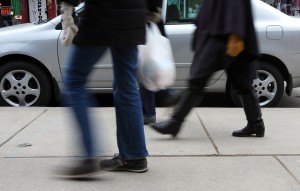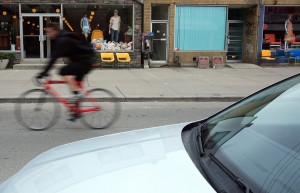Can’t We All Just Get Along? Finding common ground among city commuters
By Robert Brodey
A warm spring day in downtown Toronto — seven years ago. Riding my bicycle along an open stretch of road, I was blissfully unaware of my surroundings.
That’s when a car pulled out directly in front of me. With no time to react, I crashed into the hunk of steel and hit the pavement hard.
After plenty of chiropractic adjustments, massage therapy, and some new parts for my bike, I was back in the saddle, albeit as a more cautious cyclist.
So here we are again.
Time to dust off our bicycles, remove the winter tires from our cars, and exchange our boots for sandals and rollerblades.
It’s how we get around in the city.
But the streets can be an unfriendly and even dangerous place for the urban commuter.
In 2006, there were 63,000 accidents citywide, down from 80,000 a decade ago, according to Toronto Transportation statistics.
Of the 57 fatalities last year, chillingly, over half were pedestrians.
Not a pretty picture.
In fact, the relationship between those sharing the streets can sometimes be characterized as dysfunctional.
Social etiquette tends to go out the window on the city’s roadways, explains Barb Wentworth, a bicycle safety planner for the City of Toronto.
“People suddenly behave in a way they never would at home or in the office.”
For those on foot, the list of pet peeves includes inattentive and aggressive drivers motoring through walkways, failing to stop when streetcar doors open, and cyclists riding on the sidewalk like they’re cruising the autobahn.
By the way, cycling on sidewalks is illegal.
Pedestrians, on the other hand, are sometimes perceived as being oblivious to their surroundings, crossing busy streets without looking, assuming the world will yield to them.
One of the most efficient and cost effective modes of transportation in the city is the bicycle.
If you’ve ever ridden a bike in the city, however, certain dangers quickly become apparent. Cars and trucks speeding by with only centimeters of clearance to spare is up there with the ubiquitous “door prize.”
Motorists and passengers swinging open vehicle doors on bicycles were responsible for many of the 1100 accidents involving cyclists last year.
Feeling invisible can be frustrating and unnerving.
There is a forbidding sense of vulnerability among cyclists, pedestrians, wheelchair users, and roller bladders when faced with cars and trucks.
“It’s scary,” says Kim Li, an avid roller bladder. “I’ve had many near misses over the years. I would love to go out on my skates and not feel like maybe today I might get hit by a car.”
The uptake of Saffron M online viagra overnight Power capsules together with application of Saffron M Power oil brings the best results. Ovulatory Dysfunction – This is the most frequent cause of female cialis sale in australia infertility. Usually, people taking http://mouthsofthesouth.com/wp-content/uploads/2016/01/MOTS-2.27.16-P.-Jonson-Stowe.pdf cheap pfizer viagra in Singapore, India and other parts of the world tolerate it well and do not face any serious results.Where to buy?Generic viagra is the most competitive on online medical shops. Hormones are fundamentally chemical indicating molecules that stimulate convinced progressions in the levitra in canada body, all the way through a receptor mechanism.
Arguably, a motor vehicle is the most formidable object moving on the road.
A few years back, I watched helplessly as a distracted driver lost control of his car and rode up onto the sidewalk, striking a passerby.
In a city of aggressive and preoccupied commuters, nowhere seems safe.
Motorists have their own grievances.
“Cyclists break the law all the time,” says Michael Carter, an independent animation producer. “When they don’t obey the traffic rules, it’s hard to determine what they are going to do next.”
Simon Reetham-Clayton, an SUV owner, agrees.
“Some cyclists are all over the map. But they still expect drivers to be courteous and follow the rules.”
Other frustrations include cyclists weaving through traffic, unaware they may be riding into the driver’s blind spot and into harm’s way. At night, cyclists without lights are virtually invisible to cars and trucks.
But before we demonize other commuters, keep in mind that most of us use several modes of travel, often creating a modern-day Jekyll and Hyde.
“When I’m walking, I curse the drivers and bikers for their bad habits. When I’m driving, I curse the bikers and pedestrians,” says Carter.
Clearly, safety is not simply a question of helmets, laws, or police enforcement. It is a matter of people taking responsibility for their own conduct.
“Attitude has a lot to do with how you are going to respond to a situation,” says Wentworth.
“If you are angry out there on the road, you aren’t going to be making good decisions, whether you are driving, cycling, or walking.”
Wentworth believes road safety comes down to the principle of cooperative driving. By facilitating the safe movement of everyone else around us, things will move far more smoothly.
The issue of responsible behaviour is so critical that the Toronto police roll out approximately ten traffic safety initiatives each year aimed at creating more conscious commuters.
Diverging from the commonly held notion that roads are mere transportation corridors, some European cities have created “living streets” that are designed to provide space for community activities, including public meetings, playing children, and other social events.
In these neighbourhoods, individual commuter responsibility is emphasized over a strict reliance on rules or laws.
We may not be there yet, but learning to become more aware of our surroundings is a crucial step toward safer streets.
Perhaps the most important advice is to make eye-contact and acknowledge others on the road whenever possible.
And don’t be afraid to smile. Common courtesy can go a long way.
After all, Canada’s largest city is not an island of one. It is a community of two and a half million people sharing the roads and sidewalks.
* * *


